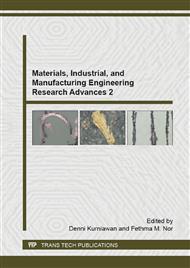p.450
p.455
p.460
p.465
p.470
p.474
p.479
p.484
p.489
Analysis on Compressibility of Dental Amalgam Using Nanomaterial Zinc Oxide (ZnO)
Abstract:
The more increasing severe impact of the mercury use on health, particularly as the amalgam material, has required an alternative innovation in order to eliminate the composition of mercury and amalgam. The objective of this research was to proposed a new biocompatible material which was called zinc oxide (ZnO). One of the innovative breakthroughs is by applying nanotechnology to ZnO, an alternative material expectedly to have better physical features and compressibility. Those physical features here including morphology, dimensions, and the comparison ratio of atom were analyzed through the test of XRD, XRF, SEM, and EDX characterization. Further, for its compressibility features, the test of compressibility was carried out using the hydraulic pressing machine with the power of 100-4000 kgf. This test was treated variously on the compression loading (500, 1000, and 2000 kg) with the variety of dwelling times (30, 60 and 90 seconds) purposely to observe its effect on the density of nanoparticles ZnO. The result of this research then shows that the physical properties of the analyzed ZnO has the particle in the size of 14,34 nm with the morphology classified as nanorods. In the compressibility test, the variation of compression loadings has brought an effect on the significant increase of density of nanoparticles ZnO. In the compression loading at 500 kg, the average of density of ZnO is at 3,170 (g/cm3) with the increase of 4,763% with the addition of the compression loading into 1000 kg. Subsequently, another increase of density again takes place by 7, 539 % in the compression load changed into 2000 kg. The variation of the dwelling times also contributed to an equal effect in which at the dwelling time of 30 seconds, the average of density of ZnO was at 3,260 (g/cm3), at the dwelling time of 60 seconds, it increased at 0,583%, and the dwelling time of 90 seconds, it again increased at 3,098%.
Info:
Periodical:
Pages:
470-473
Citation:
Online since:
October 2015
Authors:
Keywords:
Price:
Сopyright:
© 2015 Trans Tech Publications Ltd. All Rights Reserved
Share:
Citation:


